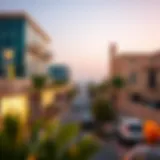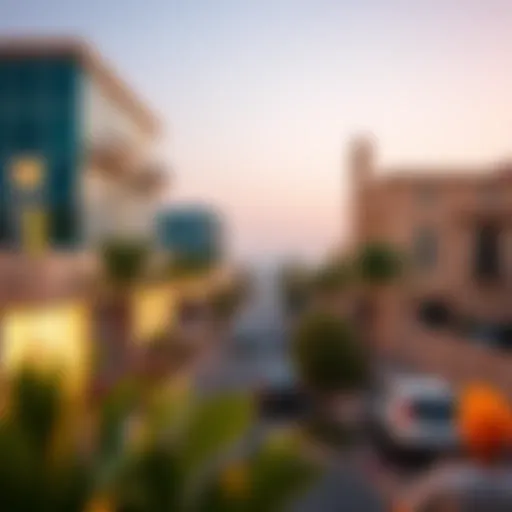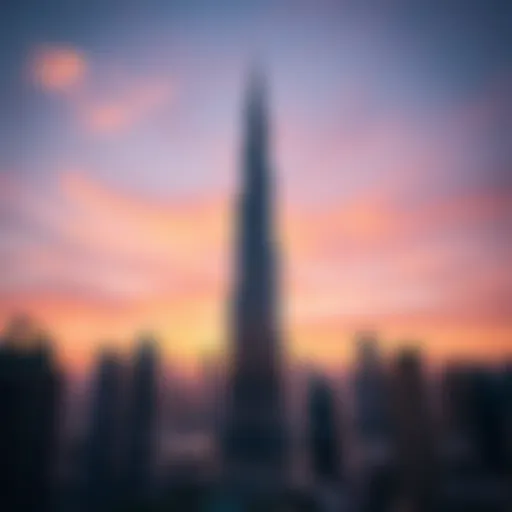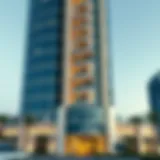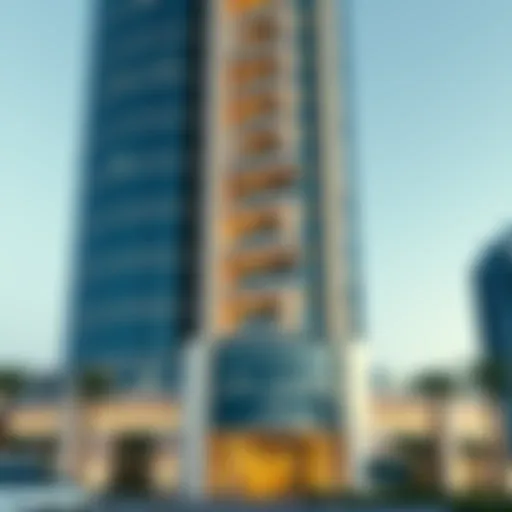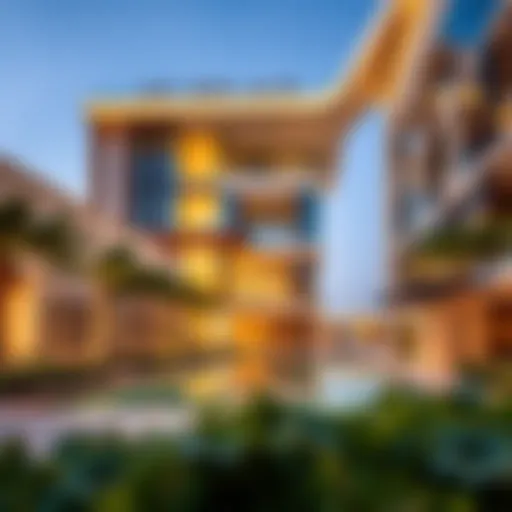Exploring the Dubai Metro Lines: Impact on Real Estate
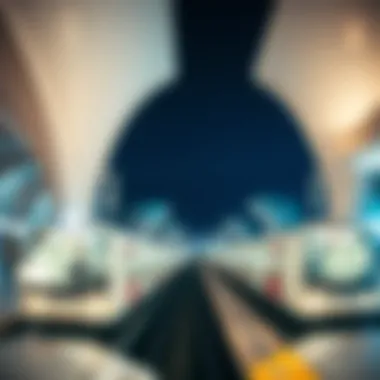

Intro
The Dubai Metro represents more than just a series of interconnected train lines; it embodies a transformational shift in urban mobility and growth. As this modern transit system snakes through the heart of the city, it lays the groundwork for a new era of real estate investment and urban development. For investors, homebuyers, and analysts alike, understanding the intrinsic bond between the Metro and property values is vital in navigating the ever-evolving landscape of Dubai’s real estate scene.
With lines that connect key districts like Downtown Dubai, Dubai Marina, and Jumeirah Lakes Towers, the Metro not only facilitates efficient commuting but also alters how residents and businesses perceive accessibility and location. Thus, it’s crucial to dive into the currents of market trends and property types that have been influenced by this pivotal transport system. Let's explore how the Metro’s expansions, ridership trends, and the configurations of residential and commercial properties are reshaping the investment tableau in the UAE.
As we traverse through this discussion, we’ll uncover insightful connections that underscore the significance of public transportation parameters on the thriving real estate market. Armed with this knowledge, stakeholders can make informed decisions that align with both current demands and future forecasts.
Overview of the Dubai Metro
The Dubai Metro, like a silver thread weaving through the vibrant tapestry of the city, stands as a testament to modern urban transportation. This rapid transit system has not only revolutionized how residents and tourists navigate the bustling streets of Dubai but also significantly reshaped the urban landscape and real estate dynamics. As a key player in the infrastructure of the United Arab Emirates, the Metro connects major commercial, residential, and recreational areas, facilitating seamless movement across the metropolis. This connectivity boost has implications reaching beyond mere convenience, impacting property valuation trends and development opportunities.
Historical Context
To truly appreciate the Dubai Metro, one must journey back to its inception. The idea of a metro system emerged in the early 1990s, driven by the city’s rapid population growth and increasing traffic congestion. Visionaries in the government recognized that traditional transportation models were not sufficient to accommodate the burgeoning population. In 2005, the Dubai Roads and Transport Authority (RTA) began its ambitious project aiming to construct a modern and integrated urban transport system. The motivations were clear—improve mobility, enhance economic prospects, and reduce the environmental footprint of transportation.
Construction Milestones
The construction of the Dubai Metro consisted of several significant milestones. After breaking ground in 2006, the first phase was completed in September 2009, comprising the Red Line. This initial segment represented a leap of faith, involving advanced technology and engineering feats. Following the success of the Red Line, which spanned 52 kilometers, the Green Line was inaugurated in 2011, further expanding the network to include more neighborhoods and key locations. Subsequent phases have included the introduction of the Blue and Purple Lines, showcasing the continual expansion driven by the city’s developing needs. Curling through the complex web of urban life, the Metro’s construction was indeed a big endeavor, completed ahead of schedule; it has set the stage for future growth.
Current Infrastructure
Today, the Dubai Metro features a sophisticated infrastructure consisting of two primary lines—the Red and Green—covering a total length of approximately 89 kilometers. The elevated and underground systems boast a combined total of over 50 stations, equipped with modern amenities for passenger comfort. Each station is designed with aesthetic appeal, reflecting the rich cultural heritage of the Emirates. Real-time information displays, free Wi-Fi access, and dedicated spaces for different categories of commuters highlight its priority for user-friendly experiences.
Moreover, the integration with other forms of transport—buses, taxis, and even marine transit—has enhanced the overall functionality of the system. This remarkable infrastructure not only makes commuting more convenient but also translates to increased demand in the surrounding areas, impacting real estate market trends.
"The Metro is not just a way to travel; it’s a catalyst fueling Dubai’s growth and development."
For investors and homebuyers, understanding this infrastructure’s evolution and its current state is crucial in navigating the real estate landscape. The choices around land use, commercial development, and residential vicinity hinge significantly on the accessibility provided by the Metro.
Detailed Exploration of Each Line
Understanding the intricate details of each line in the Dubai Metro system is essential for both residents and investors. These lines do not just serve as mere transport routes; they play a crucial role in shaping the urban landscape, enhancing connectivity, and catalyzing economic growth. Each line contributes uniquely to the overall fabric of the city. As we explore them, we will highlight specific features, the nuances of ridership, and their direct consequences on the surrounding real estate market.
Red Line
The Red Line stands as a backbone of the Dubai Metro network, linking key urban hubs and serving a diverse ridership. This section delves into crucial elements like key stops, ridership statistics, and the impact on surrounding areas, portraying how this line functions within the broader context of the city.
Key Stops
The Red Line’s key stops are strategically located at pivotal points. For instance, the Burj Khalifa/Dubai Mall station draws a significant number of visitors due to its proximity to the world-renowned tower and the largest shopping mall. This stop has become synonymous with tourist traffic, showcasing a blend of modern architecture and cultural experiences.
Moreover, the financial district is accessible via the Emirates Towers station, making it an attractive choice for professionals commuting daily. This station embodies the balance between work and leisure, as its vicinity includes restaurants and cafés, contributing to a vibrant urban lifestyle.
Ridership Statistics
When it comes to ridership, the Red Line consistently ranks among the busiest. Data indicates that millions utilize this line yearly, reflecting its importance to daily commuters and tourists alike. The steady increase in ridership underscores its reliability and efficiency. Thursday and Friday evenings often see spikes as people flock to recreational spots, indicating the line’s role in shaping weekend outings.
Impact on Surrounding Areas
The influence of the Red Line on surrounding neighborhoods has been profound. Real estate projects have flourished, with developers keenly aware of the upsurge in demand for residential and commercial units nearby. Properties within proximity to the metro stops tend to appreciate faster than those further afield, as they offer unparalleled accessibility.
Apart from immediate real estate effects, the presence of the metro has fostered a more comprehensive urban fabric, promoting sustainable living through reduced dependency on vehicles. This is something investors have noticed, creating a ripple effect on property values.
Green Line
The Green Line serves as a complementary route to the Red Line, catering specifically to the city’s diverse demographics. Its stations can be gateways to lesser-known gems within the city.
Key Stops
Among its key stops, the Al Fahidi station stands out. Situated in one of the city's historical districts, it attracts both residents and tourists keen to explore Dubai's traditional culture and heritage. Plus, with the proximity to the Dubai Museum, it positions itself as not just a transit point but a cultural hub.
The stop at Al Jafiliya, meanwhile, serves a different crowd, being close to the World Trade Centre. This combination of culture and commerce illustrates the Green Line's multifaceted role in urban mobility.
Ridership Statistics
While the Green Line may not boast the same peak numbers as the Red Line, its ridership has steadily grown, especially among local citizens and expatriates. It's appealing, particularly to those who reside in the older parts of the city where options for travel might be limited. Weekly and monthly ridership numbers reflect a developing trend towards using this line as a regular commuting choice.
Influence on Local Development
The advent of the Green Line has spurred significant local development. The presence of stations has encouraged investors to back the construction of high-rise buildings and mixed-use developments, knowing that accessibility significantly elevates the desirability of their projects. This burgeoning relationship between transport accessibility and real estate development underscores a common trend seen in urban planning.
Blue Line
Projected to expand the existing transport network, the Blue Line is designed to cater to the future growth of Dubai. It holds promise not just in connectivity but in evolving community landscapes as well.
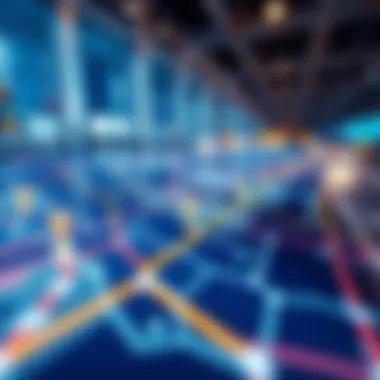

Projected Route
The projected route of the Blue Line is particularly keen on addressing underserved areas and enhancing east-west connectivity across the city. While the precise specifics are still in development phases, the route includes access to areas that have seen incremental growth yet lack adequate public transport options. It’s a strategic choice for the city's expanding metro system.
Community Impact
The anticipated Blue Line will influence local communities, especially neighborhoods that have been overlooked. By connecting these areas to the wider metro system, it will likely provoke an uptick in local business activity as transportation barriers diminish. Residents can expect improved access to education, healthcare, and employment opportunities, reshaping community interactions.
Investment Opportunities
The Blue Line tells a compelling story of future investment potential. For real estate developers, the planned stops along the Blue Line present unparalleled opportunities to construct residential and commercial properties tailored to emerging market demands. Investors recognizing this potential could find themselves ahead of the curve, shaping the next phase of Dubai's dynamic urban landscape.
Purple Line
Looking forward, the Purple Line is projected to enhance existing connectivity, bringing new possibilities to the metro network.
Expected Features
The expected features of the Purple Line are set to include advanced amenities such as smart ticketing and enhanced safety measures, a crucial factor for encouraging usage. These features can serve to attract not only everyday commuters but also occasional users who may be hesitant without a streamlined process.
Integration with Existing Lines
A core advantage of the Purple Line lies in its planned integration with existing lines. This integration ensures seamless travel across the network, eliminating bottlenecks and facilitating smoother transitions between lines. Such connectivity can improve ridership and enhance passenger satisfaction.
Development Potential
The potential for development surrounding the Purple Line is vast, particularly with regards to mixed-use spaces that combine commercial, residential, and recreational facilities. Forward-thinking developers may find lucrative opportunities awaiting them in proximity to the new stops, echoing the previous patterns seen with the Red and Green Lines.
As the metro continues to evolve, it reflects the vision of a forward-focused, interconnected city that prioritizes convenience and sustainability for its citizens.
In summary, the exploration of each metro line highlights the tangible effects on urban lifestyle and real estate dynamics within Dubai. Investors and homebuyers alike must consider how each line functions and the benefits that these transit options can yield in terms of property values and community growth.
Operational Efficiency
Operational efficiency is a pivotal element within the context of the Dubai Metro, fundamentally influencing how this infrastructure impacts urban mobility, real estate dynamics, and the overall economy. By ensuring that the metro system operates smoothly and effectively, the benefits extend far beyond mere transportation. Travelers experience shorter wait times, more reliable service, and increased safety—all factors contributing to a richer urban experience. Moreover, operational efficiency is crucial as it directly correlates with the appeal of nearby properties and the economic viability of developments in their vicinity.
Speed and Frequency
The speed and frequency of metro services serve as the backbone of its operational efficiency. As commuters juggle busy schedules, the quicker they can navigate the city, the more inclined they are to opt for public transport over private vehicles. In Dubai, the metro boasts trains running every few minutes during peak times, translating to less time spent waiting around and more time to engage in other pursuits. This efficient scheduling not only captures the attention of morning commuters jostling for a spot on the train but also appeals to potential residents and investors evaluating property near stations.
"Frequent metro services transform public perception about commuting; the more reliable the schedules, the easier it becomes for residents to embrace public transport as a primary means of travel."
Technological Innovations
In a world enveloped by technological advancements, the Dubai Metro does not hold back on leveraging innovation to improve its operational efficiency. Smart systems are integrated into various aspects, from ticketing to train management. For instance, the use of automated train operations enhances safety and speeds up response times, refining what could be a cumbersome process. Additionally, technological developments enable real-time tracking through mobile applications, allowing passengers to access necessary information instantly. This interconnectedness makes navigating through the metro easier and more accessible, solidifying its role as a preferred choice for urban transit.
Safety Measures
Safety is an undeniable cornerstone of operational efficiency. The confidence of users in the metro service directly ties to the measures put in place to ensure their security while traveling. With various protocols, including surveillance systems and emergency training for staff, Dubai Metro stands on solid ground. The commitment to passenger safety reflects not only in infrastructure but in the strategic planning of routes that prioritize high-traffic areas. This emphasis on safety reassures potential property buyers and investors that areas surrounding metro stations are constructed with residents’ well-being in mind, a factor that can significantly elevate property values in these neighborhoods.
Through a careful examination of operational efficiency, it becomes evident that the relationship between metro systems and urban development is intricate and mutually beneficial. As the Dubai Metro continues to evolve, its role in shaping the real estate market will undeniably intensify.
Economic Impact of Metro Lines
The economic significance of the Dubai Metro cannot be overstated; it is a catalyst for growth and transformation across multiple sectors in the UAE. By facilitating efficient movement within the city, the Metro enhances productivity, reduces travel time, and boosts local businesses. The vital link between efficient public transport and economic vitality is evident in urban landscapes around the globe.
Not only does the Metro serve daily commuters, but it also plays a crucial role in attracting tourists and investors, enhancing the overall appeal of Dubai as a vibrant metropolis. Understanding the economic implications of the Metro lines allows businesses, investors, and policymakers to harness opportunities in this bustling city.
Contribution to Local Economy
The Dubai Metro contributes significantly to the local economy in numerous ways. First and foremost, it enhances accessibility to various commercial hubs, which can lead to increased foot traffic. Businesses located near key metro stations often experience a rise in sales due to the influx of potential customers. Furthermore, the transportation infrastructure supports local tourism, making it easier for visitors to explore the city's attractions.
- Increased Investment: The enhanced connectivity from the Metro has spurred foreign investment, as international firms are more likely to establish a presence in accessible locations.
- Boost to Local Businesses: Cafes, restaurants, and retail shops near metro stations have reported increased patronage since the Metro's inauguration.
- Real Estate Development: New developments around Metro stations have increased the property market value, leading to a surge in both residential and commercial developments.
This synergy between the Metro and local economy creates a ripple effect of prosperity for businesses and residents alike. When the Metro connects areas previously regarded as less accessible, it opens new markets and opportunities for entrepreneurship.
Job Creation and Opportunities
The advent of the Dubai Metro has also been a boon for employment. Job creation surrounding the Metro is multifaceted. Construction jobs during the development phase played a significant role, but the ongoing operations of the Metro continue to provide numerous opportunities in various sectors.
- Operational Workforce: The Metro requires a well-trained workforce for its operation, from train drivers to station attendants. This generates a steady flow of employment opportunities.
- Support Industries: The growth of related industries, such as maintenance services, logistics, and hospitality, results in further job opportunities, enhancing societal development.
- Skills Development Programs: Many organizations have started initiatives to train individuals seeking employment in industries linked to the Metro’s operations, ensuring a skilled labor pool and potentially lowering unemployment rates within the city.
In essence, the economic landscape surrounding the Dubai Metro illustrates how transportation infrastructure can enrich communities and support a thriving economy. The continuing ripple effect of its growth not only enhances mobility but also lays the groundwork for sustained economic prosperity.
Real Estate Market Implications
The real estate landscape around the Dubai Metro is akin to a chessboard, with strategic placements and moves that reveal the true value of proximity to transit lines. Understanding the implications of metro lines on the market is crucial for investors and homebuyers alike. This section unpacks how metro connectivity contributes to property values, housing demand, and the nuances of commercial real estate dynamics.


Property Values Near Metro Stations
The allure of living near a metro station is like a moth to a flame—it’s hard to resist. Properties situated close to metro stations often witness a spike in value as demand surges. The basic principle here is straightforward: accessibility breeds desirability. As public transit enhances ease of commuting, buyers and renters eye these locations with favor.
- Convenience Over Cost: Residents are willing to pay a premium for the convenience of metro accessibility. Being able to hop on a train and avoid traffic jams can be an attractive selling point, especially for professionals.
- Price Trends: Recent reports indicate that properties within a half-kilometer radius of metro stations have seen appreciation rates significantly outpace those further away. For instance, flats in areas like Dubai Marina and Business Bay have shown robust growth tied to their metro proximity.
- Investment Potential: Investors note that buying property near transit hubs is often a safer bet due to consistent demand over time, solidifying the case for higher returns on investment.
To further illustrate:
"The average resale value for properties adjacent to the Dubai Metro line has increased by over 20% in the past three years alone."
Trends in Housing Demand
As connectivity improves, so does the appetite for housing in those areas. The ebb and flow of housing demand follow a predictable pattern influenced heavily by metro expansions. It is crucial to recognize how these trends shape not just individual decisions, but also broader market sentiments.
- Changing Demographics: The influx of a younger workforce and expatriates has shifted demand to areas with fast transit options. Millennials and Gen Z renters are increasingly prioritizing location and transit access over square footage.
- Shift to Suburban Living: With the metro extending to suburban areas, there is a noticeable shift in demand, with people seeking homes in less dense environments, provided they have reliable metro services.
- Projected Increases: Some analysts forecast that as more lines are introduced, housing demand will proliferate, especially in the emerging neighborhoods along these routes. Expect spikes especially following announcements of future line expansions.
Impact on Commercial Real Estate
The ramifications of metro connectivity extend into the commercial domain as well. Businesses are strategically positioning themselves to capture foot traffic generated by nearby transit users. This trend alters the business landscape significantly.
- High-Traffic Areas: Commercial properties near metro stations are often buzzing with potential customers. Retailers, restaurants, and service providers are keen on these locations to maximize visibility and accessibility.
- Attracting Corporations: Companies seeking office space are now leaning toward properties that offer easy commutes for employees. Areas around metro stations like Downtown Dubai often become focal points for corporate offices looking to draw talent.
- Rental Prices Surge: As demand escalates in conjunction with increased foot traffic, rental prices for commercial spaces have shot up. Businesses are finding it worthwhile to invest in areas that are well-served by public transit systems.
The interaction between the Dubai Metro and the real estate market is interwoven and multifaceted, shaping the dynamics of urban living and investment opportunities. The importance of proximity to metro stations cannot be overstated, as it fundamentally influences market attractiveness and the viability of both residential and commercial properties.
Societal Benefits of Metro Expansion
The expansion of the Dubai Metro serves as a cornerstone in enhancing urban life and community engagement across the city. As a bustling metropolis, Dubai continues to grow, necessitating efficient public transportation solutions. The societal benefits of the metro’s expansion go beyond mere convenience; they tangibly improve the quality of life for residents and visitors alike, contributing to a more connected, sustainable, and vibrant urban environment.
Enhanced Mobility
One of the most pivotal enhancements brought by the Dubai Metro is the increased mobility it offers to the population. With the metro spanning extensive areas of the city, it allows commuters to navigate urban terrains that once required extended travel times or the hassle of congested roads. Convenience reigns supreme here. For example, a resident in Al Qusais can now easily reach the bustling Dubai Mall without the headache of traffic delays. This shift not only reduces commute times but also diminishes stress levels associated with driving in heavy traffic.
"The efficiency of the metro empowers residents; they can focus on life, not on traffic."
The advanced schedule of the trains, running frequently throughout the day, ensures that waiting times are minimal. People can hop on and off as they please, making it easier to visit friends, run errands, or take part in cultural events. Moreover, the platform accessibility provided by the metro caters to people with diverse mobility needs, reinforcing inclusivity.
Environmental Impact
Another cornerstone benefit related to the metro expansion revolves around its environmental impact. As a public transport system, the Dubai Metro encourages a significant reduction in carbon emissions compared to car travel. The investment in sustainable technologies, such as energy-efficient trains, marks a commitment to greener urban infrastructure. This approach not only aids in combating air pollution but also aligns with the UAE's initiatives for sustainability, contributing to a cleaner future.
- Reduction in Car Usage: With more people relying on the metro, there are fewer cars on the road, leading to decreased traffic congestion and lower vehicle emissions.
- Noise Pollution Reduction: The design and operation of the metro system incorporate methods to minimize noise, enhancing the serenity of urban living.
- Green Energy Utilization: The metro often harnesses alternative energy sources, implementing solar panels at various stations, which showcases Dubai’s push toward renewable energy.
These eco-friendly measures resonate well with both locals and tourists, as the skyline embraces modern transport solutions while fostering a commitment to environmental stewardship.
Community Amenities and Accessibility
The expansion of the metro also bolsters community amenities and accessibility. New stations often lead to the development of surrounding areas, drawing in businesses, cafes, and parks—all of which elevate local living conditions. For instance, the opening of Abu Dhabi metro stations in key districts serves as a catalyst for local commerce, allowing restaurants and shops to thrive due to increased foot traffic.
Furthermore, the easy access to vital services such as hospitals and educational institutions drastically enhances community livability. Families are no longer confined to residing near their workplaces; they can choose neighborhoods based on personal preferences, knowing they have reliable transit alternatives.
- Improved Community Connections: The metro acts as a unifying thread for different districts, allowing for greater interaction among diverse communities.
- Enhanced Local Development: Developers can see the opportunity presented by proximity to metro stations, likely spurring higher property values and investment incentives in those areas.
- Accessible Amenities: The metro connects people directly to important lifestyle amenities, reducing travel time to essential services.
Future Expansion Plans
The Dubai Metro has transformed the urban landscape and public transportation in the emirate, but as with all thriving systems, the journey doesn’t stop here. Future expansion plans are critical for catering to the ever-growing population and enhancing connectivity across the city. A well-connected metro system paves the way for economic growth, community development, and real estate elevation. By examining upcoming lines and extensions, we can gauge the potential shifts in residential and commercial markets as they adapt to new transit possibilities.
Proposed Lines and Extensions
Dubai's metro expansion includes several proposed lines and extensions aimed at linking key areas and enhancing accessibility. This includes plans for the Blue Line, which will extend towards Dubai Marina from its initial terminal. Additionally, the Orange Line is considered, potentially serving areas like Dubai South and the new Al Maktoum International Airport, facilitating easier transit for both residents and visitors.
Here’s a quick rundown of some notable proposed lines:
- Blue Line: Connects Dubai Marina and further inland areas, promising better access for new developments in the vicinity.
- Orange Line: Targets key developments in Dubai South and aligns with future projects like the Dubai Expo 2020, aiming to attract significant tourist flows.
- Pink Line: Planned to enhance connectivity across the Dubai Creek area, enriching cultural and economic exchanges.
These expansions are not just about adding more routes but also about making the Dubai Metro a lifeline that feeds into the real estate market, boosting property values and demand in the areas served.
Projected Benefits of Future Developments
The benefits of these forthcoming developments will ripple across the economic fabric of Dubai. One of the primary rewards of expanding the metro system includes increased property values around stations. There’s a palpable increase in housing demand when proximity to public transport improves. A few of the key projected benefits are:
- Enhanced Accessibility: More metro lines mean easier onboarding to various parts of the city. This convenience is attractive to prospective home buyers and renters.
- Revitalization of Neighborhoods: Areas that may have been overlooked can see a rejuvenation, driven by the prospect of better transportation linkages.
- Economic Opportunities: With increased accessibility, businesses are more likely to set up near new metro lines. This fosters job creation, which in turn, attracts more residents to the area.
- Sustainable Development: The shift towards public transportation aligns with global trends in urban living and sustainability. Enhanced metro accessibility can encourage people to opt for public transport over personal vehicles, reducing traffic congestion and emissions.
"The expansion plan focuses on not just transport but the very fabric of urban living, binding communities closer together while paving the way for economic prosperity."
Ultimately, these future expansions are stepping stones to a more connected, vibrant Dubai, where investors, homebuyers, and developers alike can find opportunities that showcase true value and potential in the city's ongoing evolution.
Challenges and Considerations
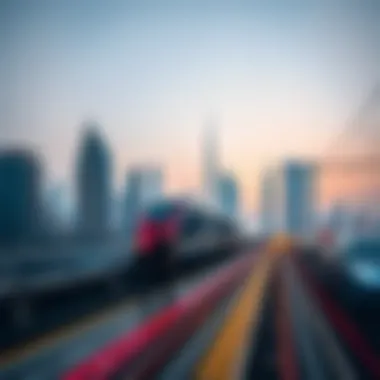

Understanding the challenges and considerations associated with the Dubai Metro project is pivotal for grasping its comprehensive impact on urban development and the real estate market. The metro has significantly transformed the landscape of Dubai, but it hasn't been a walk in the park. By diving deep into the financial, urban planning, and societal aspects, stakeholders can better appreciate both the triumphs and tribulations that accompany such a massive infrastructure project.
Funding and Budget Constraints
Financial backing remains the backbone of any large-scale project, and the Dubai Metro is no exception. The initial phases of construction faced budgetary challenges that influenced timelines and scope. The key to success in this regard has been the Dubai government’s willingness to invest. However, funding challenges still loom in the context of future expansions and updates.
Many potential investors might ponder whether budget constraints could hinder further development. It's worth noting that the metro system relies heavily on public funds and often encounters fluctuations based on economic conditions. Delays in funding can lead to increased construction costs over time, raising the stakes for developers
- Example of Financial Strategy:
A classic approach to funding metro systems globally is through public-private partnerships (PPPs). In some instances, inviting private investments allows for a shared burden of costs, ultimately speeding up the development timeline. This model may prove beneficial for Dubai’s future phases as they strive to achieve greater connectivity without overburdening public debt.
"The future of public transportation systems like the Dubai Metro hinges on sustainable financial strategies, ensuring projects remain viable amid economic shifts."
Urban Planning Challenges
Urban planning isn’t just a catchy phrase; it’s a nuanced field that requires balancing various competing interests. The expansion of the Dubai Metro directly affects land use, with planners tasked with integrating the new infrastructure into the existing urban fabric. Integrating new lines means considering how new developments will interact with residential areas, commercial zones, and public spaces.
One significant challenge is preventing urban sprawl while trying to enhance connectivity. The ideal scenario is a cohesive urban environment that doesn’t stretch resources thin. Community feedback has also shaped urban planning decisions; residential areas near stations have vocally expressed concerns over noise and traffic.
- Balancing Interests:
- Local Residents: Want minimal disruption and optimal benefits.
- Businesses: Seek accessibility and visibility to draw foot traffic.
- Transportation Authorities: Aim for efficiency without overextending resources.
Public Perception and Adjustment
Public perception plays an equally crucial role in the success of the metro. While some residents embrace the convenience that the metro brings, others remain skeptical about its impact on their daily routine. Initial resistance to change can often come from adjustments in commuting habits or concerns regarding safety and cleanliness.
The Dubai Metro has made strides in addressing these concerns by implementing community awareness campaigns and improving amenities. Nonetheless, realignment of public perception takes time.
- Engagement Strategies:
- Regular surveys to gauge passenger satisfaction
- Community workshops to address concerns
- Social media outreach to share updates and success stories
Fostering positive relationships between urban authorities and local residents ensures smoother transitions during expansions and can ultimately help to cultivate community support for the project.
In sum, while the challenges surrounding funding, urban planning, and public perception can seem daunting, they are integral to sustaining the long-term vision for the Dubai Metro. As stakeholders navigate these hurdles, the collective goal remains clear: to enhance connectivity while contributing positively to the real estate market and urban life.
User Experience
Passenger Feedback and Suggestions
Understanding passenger feedback is vital in shaping the future of the Dubai Metro system. Travelers have various expectations, and their insights can offer significant changes for improvement. Many commuters have expressed that the ease of navigation is crucial. They suggest that clearer signage could help first-time riders feel less overwhelmed in the bustling stations.
Additionally, passengers appreciate the availability of real-time updates on trains. Suggestions for adding more screens displaying arrival times would enhance the user experience, contributing to a smoother journey. Many commuters have also mentioned the importance of cleanliness and maintenance in trains and stations, emphasizing that a tidy environment enhances their commuting experience.
Furthermore, social media platforms like Facebook offer a space for users to voice their opinions. Reviewing comments there reveals a consistent pattern; individuals often seek better Wi-Fi connectivity to stay connected during travels.
"A passenger's comfort contributes significantly to the overall efficiency of the metro system, so taking their feedback into account is not just good practice; it's essential for ongoing success."
Comparative Analysis with Other Transit Systems
When we look at User Experience in terms of the Dubai Metro compared to other global transit systems, it becomes clear that each has its strengths and weaknesses. For example, the Tokyo Metro, renowned for its punctuality and efficiency, boasts an extensive network with intricate routes. However, the sheer volume of passengers can make it chaotic at peak hours. In contrast, the Dubai Metro, while perhaps not as expansive yet, offers a streamlined experience, especially for tourists who are new to the city.
Key elements to note include:
- Seating Availability: Unlike some systems, the Dubai Metro provides ample seating capacity. Many riders comment on the comfort found here compared to busier metro lines in cities like London, where overcrowding can be a significant concern.
- Technology Integration: The incorporation of smart technology in ticketing systems sets the Dubai Metro apart. Mobile payments and contactless entry have made travel easier for many. In comparison, systems like New York City's MTA are gradually adapting but still lack widespread capabilities in this area.
- Accessibility Features: The Dubai Metro also provides dedicated facilities for those with disabilities, which is not uniform across all transit systems.
Travelers and investors alike should take these comparisons into account when considering the attractiveness of the Dubai Metro system, especially in relation to its potential impact on real estate and urban development. The user experience is not simply a matter of convenience but also creates a ripple effect across various sectors, notably housing and business opportunities.
By continuously refining user experiences based on passenger feedback, the Dubai Metro can secure its reputation as a world-class transit system.
Culmination
The importance of drawing conclusions in this discussion centers not only on the infrastructure itself but also on its profound impact on societal dynamics and the real estate landscape in Dubai. Metro connectivity revolutionizes urban mobility, fostering greater interaction among communities and elevating the value of properties in proximity to stations. Understanding this relationship creates a sharper lens for investors and homebuyers alike, as they navigate the ever-evolving market.
An orderly public transport system, like the Dubai Metro, facilitates the ease of commute, encouraging more people to pursue opportunities in business and lifestyle across different locales within the city. Consequently, areas surrounding metro stations often experience increased demand for housing and commercial properties, resulting in a noticeable uptick in prices.
Moreover, as businesses capitalize on this organic traffic flow, the economic benefits ripple through the community, creating jobs and enhancing local economies. Greater accessibility correlates with improved community amenities, making neighborhoods more desirable, not just for residents, but for potential investors as well. In essence, the metro system cultivates an ecosystem of growth and development.
Also, it's worth considering the sustainability implications of a robust transit system. As the Metro reduces dependency on cars, the environmental footprint lessens. This aspect can attract eco-conscious buyers who value sustainability as part of their purchasing decisions.
As we synthesize insights collected throughout this article, it becomes crystal clear: the Dubai Metro is not merely a transportation system but a catalyst for change in real estate and urban connectivity.
Summary of Key Insights
- The Dubai Metro significantly enhances mobility across the city, influencing property values.
- Areas near metro stations experience heightened demand for both residential and commercial real estate.
- Economic growth is stimulated through job creation and improved local amenities due to increased foot traffic from the Metro.
- The environmental benefits stemming from reduced car reliance echo the growing trend towards sustainability in urban living.
Future Outlook for Dubai Metro and Real Estate
The future appears promising for the Dubai Metro, especially as expansion plans aim to integrate more areas into its network. With proposed lines and extensions, the Metro will likely amplify its role in shaping the cityscape. Investors should keep a keen eye on emerging districts far from the current lines as increased connectivity could create newfound interest and opportunities.
A greater network not only facilitates sustained urban development but also positions real estate as a forefront investment opportunity. The interplay between the Metro's growth and evolving market dynamics could lead to a renaissance in sectors previously overlooked. Investors who align their strategies with the future trajectory of the Metro are likely to benefit from enhanced property values and returns on investment. With this synergy in mind, keeping abreast of regulatory frameworks and funding initiatives will be equally paramount to navigate the path ahead successfully.
As the project continues to develop and adapt, it’s clear that the Metro has a vital part to play in maintaining the momentum of urban cohesion and is set to redefine Dubai's landscape over the coming years.
